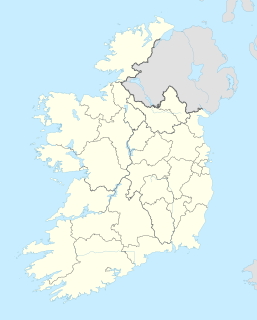
The Grianan of Aileach is a hillfort atop the 244 metres (801 ft) high Greenan Mountain at Inishowen in County Donegal, Ireland. The main structure is a stone ringfort, thought to have been built by the Northern Uí Néill, in the sixth or seventh century CE; although there is evidence that the site had been in use before the fort was built. It has been identified as the seat of the Kingdom of Ailech and one of the royal sites of Gaelic Ireland. The wall is about 4.5 metres (15 ft) thick and 5 metres (16 ft) high. Inside it has three terraces, which are linked by steps, and two long passages within it. Originally, there would have been buildings inside the ringfort. Just outside it are the remains of a well and a tumulus.

Ranaghan is a townland and archaeological site in County Westmeath, Ireland.

Fore is a barony in northern County Westmeath, Ireland. It was formed by 1672.

Rath is a hamlet in the south west area of County Offaly, Ireland. The hamlet is located midway between the towns of Birr and Kilcormac on a northeast-southwest country road. It is located in the parish of Eglish and Drumcullen which is in the Roman Catholic Diocese of Meath. The hamlet has a number of local amenities for the local population including a church, a national school, a local community centre and a local shop. Drumcullen GAA is the local GAA club and is located about half a kilometre to the south of the hamlet.

Rathborney, sometimes Rathbourney, is a civil parish in the Barony of Burren in County Clare, Ireland.

Longstone Rath is a ringfort (rath) and National Monument located in County Tipperary, Ireland.

Ardmulchan Fort is a ringfort (rath) and National Monument located in County Meath, Ireland.

Robertstown Fort is a ringfort (rath) and National Monument located in County Meath, Ireland.

Danestown Fort is a ringfort (rath) and National Monument located in County Meath, Ireland.

The Aghaward fort is a ringfort (rath) and National Monument located in County Longford, Ireland.

Larkfield fort is a ringfort (rath) and National Monument located in County Longford, Ireland.

Sonnagh fort is a ringfort (rath) and National Monument located in County Longford, Ireland.

Carron fort is a ringfort (rath) and National Monument located in County Tipperary, Ireland.

Rathanadav, also called Carron Henge, Rathnadob, Rathnadov or Fort Aengus, is a ringfort (rath) and henge, and a National Monument located in County Tipperary, Ireland.

Tornant Moat is an Irish National Monument composed of a ringfort and nearby barrows.

Rathealy Ringfort is a ringfort (rath) and National Monument located in County Kilkenny, Ireland.

Cashelmore, also called Clogher Stone Fort, is a stone ringfort (cashel) and National Monument located in County Sligo, Ireland.

Cashlaungar, also Cashlaungarr, Cashlaun Gar or Cashlán Gar, is a stone ringfort (cashel) and National Monument located in The Burren, a region in County Clare, Ireland.

Cahervagliar is a ringfort (rath) and National Monument (#233) located in County Cork, Ireland.

Loher Cashel is a stone ringfort (cashel) and National Monument located on the Iveragh Peninsula, Ireland.









